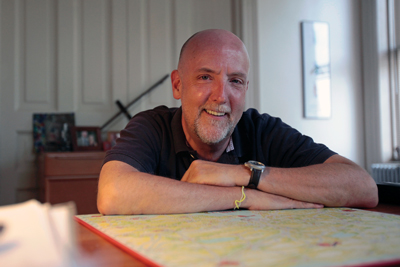
Earl Swift, BA political science 1983, has had a long and storied career as a journalist and author. His work has taken him to Christchurch, New Zealand, Anchorage, Alaska, and Southeast Asia. (Photo by Hyunsoo Leo Kim/The Virginian-Pilot)
Earl Swift’s original plan for college called for a brief stay at the University of Missouri–St. Louis, followed by a transfer to the University of Missouri–Columbia to enroll in its famed Missouri School of Journalism.
A funny thing happened on the way to Columbia, though. Swift fell in love with UMSL.
“Once I was at UMSL, I got deeply involved in The Current (UMSL’s student newspaper), then got a job working at the late, great St. Louis Globe-Democrat,” Swift says. “And as I was already doing what I’d be learning to do in the J-school, I decided I’d be better served by staying put and studying the subject matter I’d someday be covering. That led me to political science, with a healthy side helping of history.”
Swift has gone on to enjoy a remarkable career in journalism. After graduating from UMSL in 1983 with a bachelor’s degree in political science, he went on to work at the Globe-Democrat, Anchorage (Alaska) Times and the Virginian-Pilot in Norfolk.
Swift’s career has sent him all over the world – Southeast Asia, Papua New Guinea, Europe and most of the 50 states. He’s hiked the Appalachian Trail, crash-landed in a hot air balloon, paddled a kayak 700 miles around the Chesapeake Bay, lived at the top of a lighthouse and backpacked through the New Zealand bush in search of extinct birds.
In 1994, Swift was selected to participate in the Fulbright Scholar Program, which sends 800 U.S. faculty and professionals abroad each year.
“I was in Christchurch, New Zealand, writing for a newspaper there, the Press,” he says. “I got exposure to the Kiwi style of journalism; they got a little training in American-style feature writing.”
Many magazines have published Swift’s feature stories, including PARADE, Popular Mechanics, Best Newspaper Writing and River Teeth. He’s also written four books.
His latest, “The Big Roads” (Houghton Mifflin Harcourt, 2011), tells the story of how the country’s network of superhighways – officially the Dwight D. Eisenhower System of Interstate and Defense Highways – came to be, and the myriad ways it has changed America. It points out that the system was conceived far earlier than most people think.
“One of the things that book reviewers have focused on is that President Eisenhower didn’t have much of a hand in the system’s creation, though it bears his name,” Swift says.
Those same reviewers praised “Big Roads.” The New York Times named it an Editor’s Choice, and the St. Louis Post-Dispatch picked it as one of the Best Books of 2011.
Swift’s other books are: “Journey on the James: Three Weeks Through the Heart of Virginia” (University of Virginia Press, 2001), about a 22-day, 435-mile canoe trip down the James River in Virginia; “Where They Lay: Searching for America’s Lost Soldiers” (Houghton Mifflin, 2003), for which he accompanied an Army archaeological team into the Laotian jungle on a hunt for the remains of a helicopter crew shot down 30 years before; and “The Tangierman’s Lament” (University of Virginia Press, 2007), a collection of stories.
Swift is unrestrained in his appreciation of the education he received at UMSL and says the university made a profound contribution to his success.
“More than my DNA,” he says. “I loved my experience at UMSL. I grew up there; who I am today is a direct product of the place and its people.
“I had wonderful teachers, in and out of the classroom. I was encouraged to try things at UMSL that I probably wouldn’t have attempted elsewhere. Not all of my experiments succeeded, but I was always led to believe the attempt was worthwhile, in itself. That attitude became ingrained in me.”
This story was originally published in the spring 2012 issue of UMSL Magazine.














